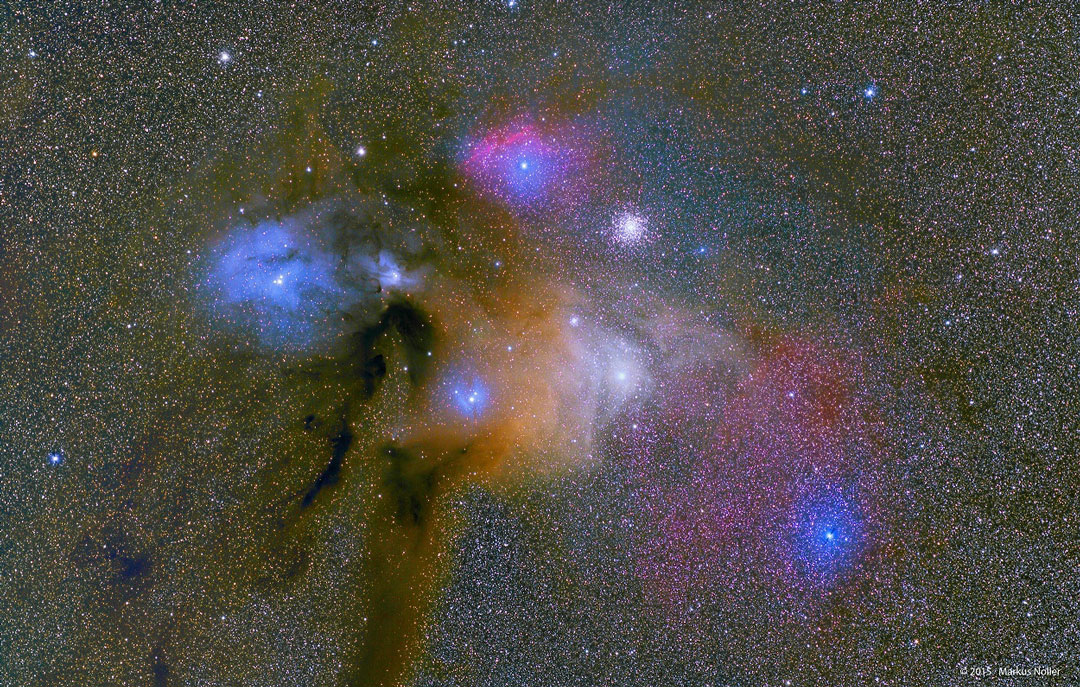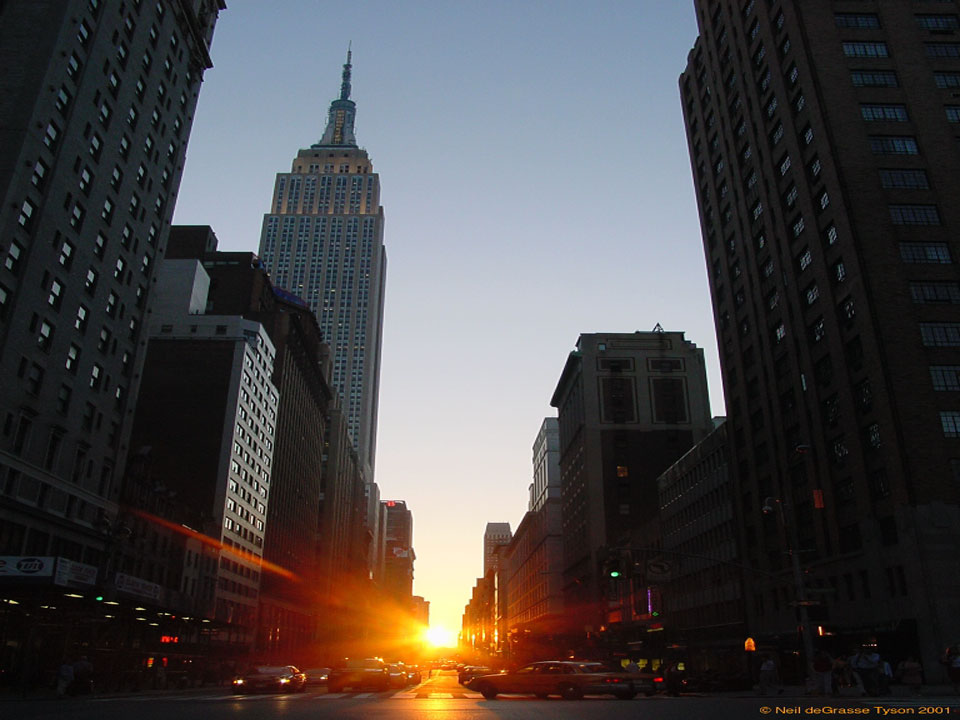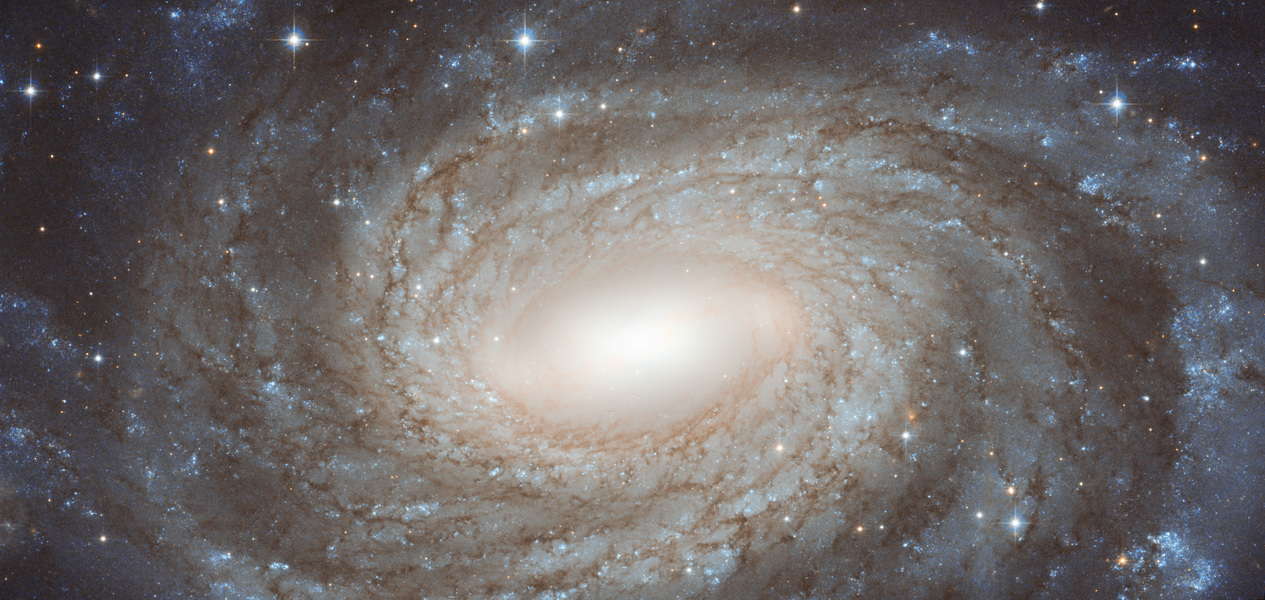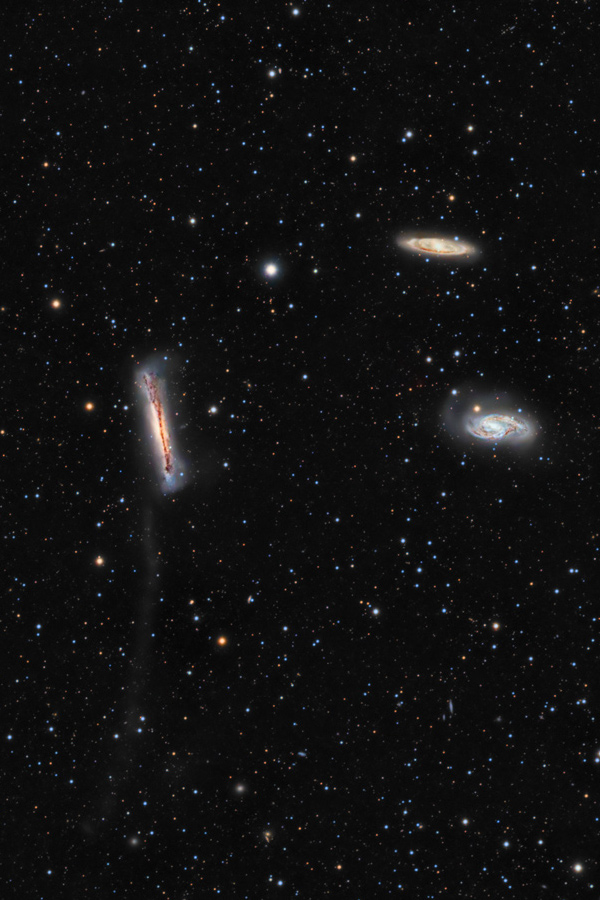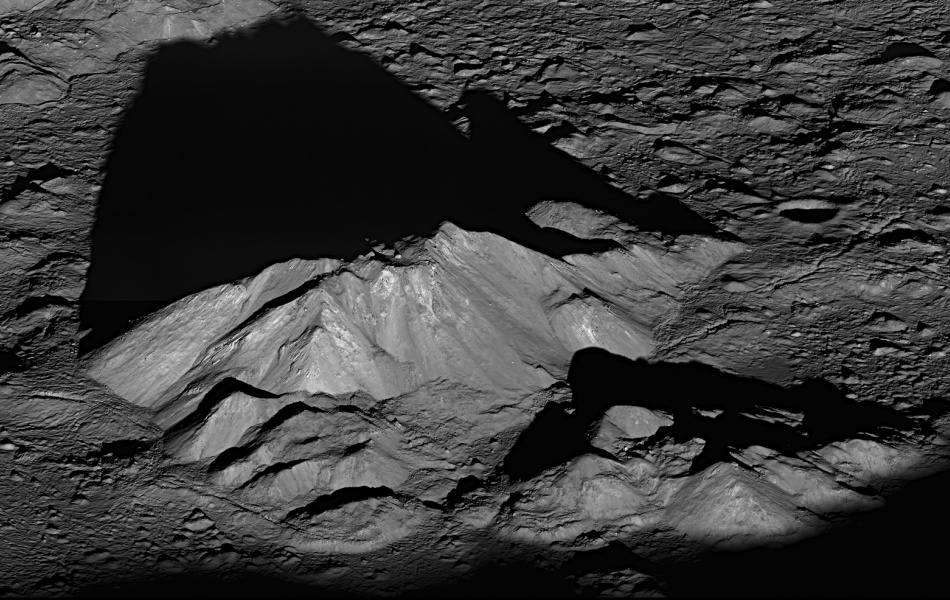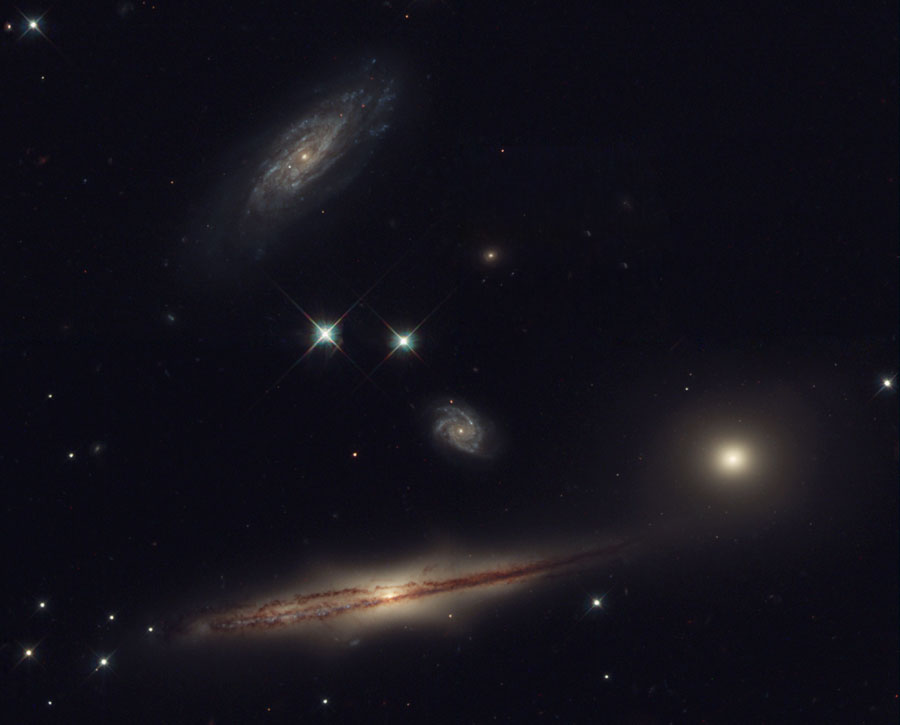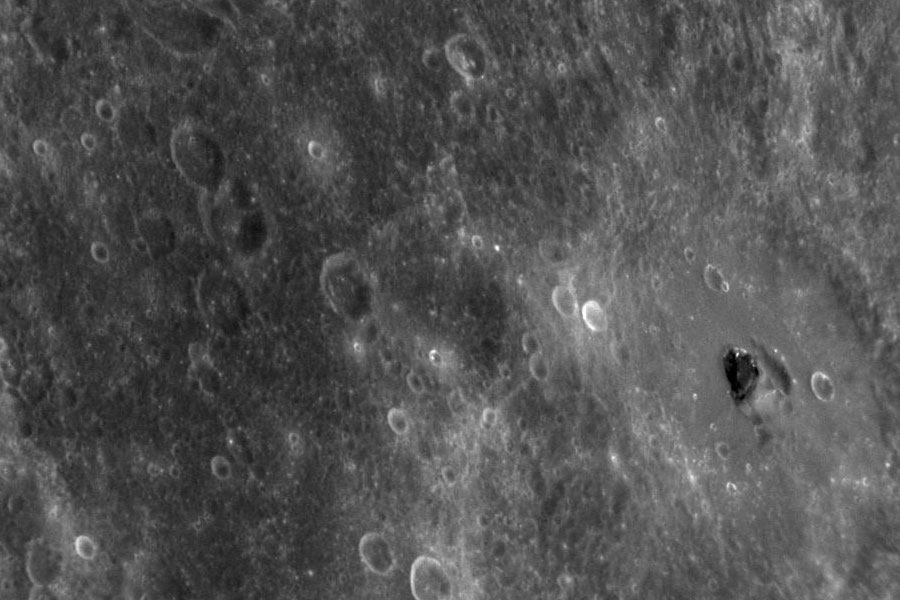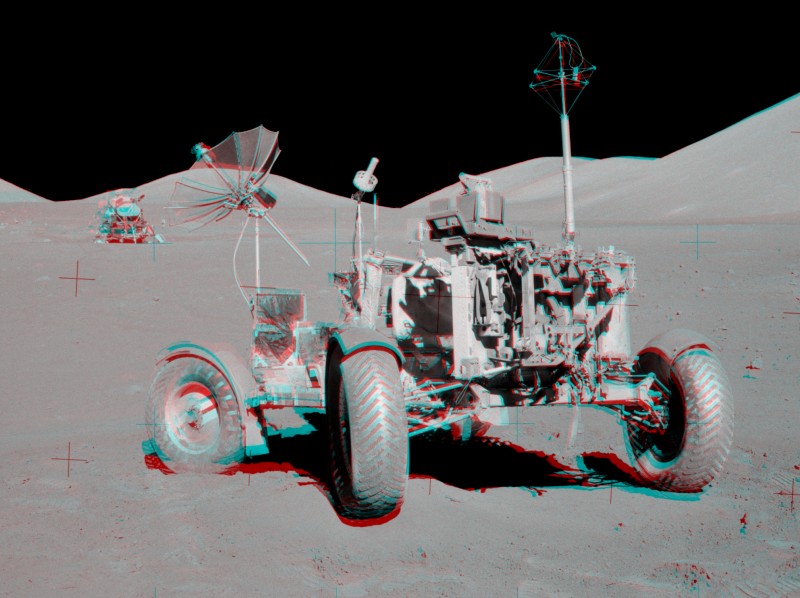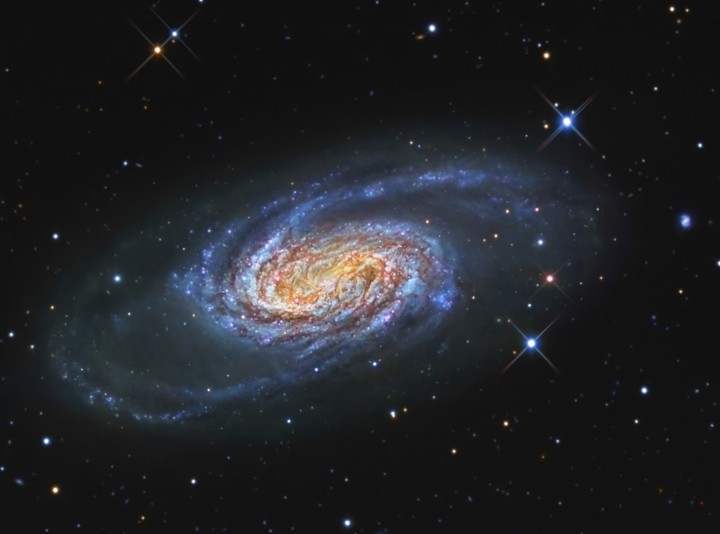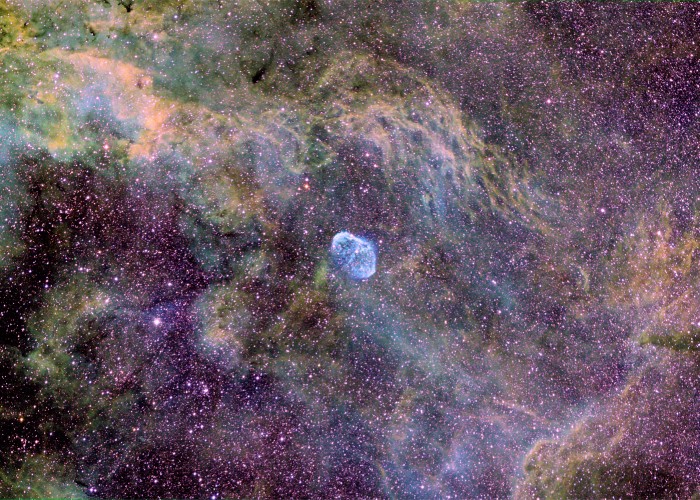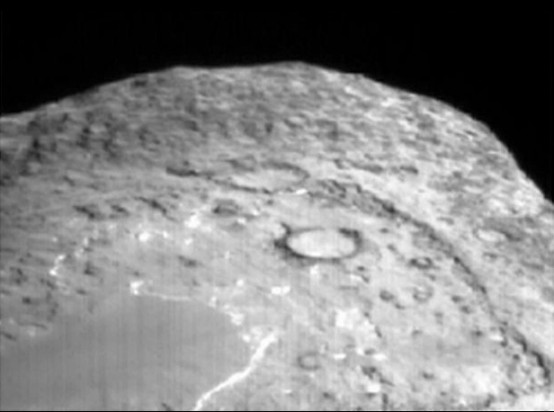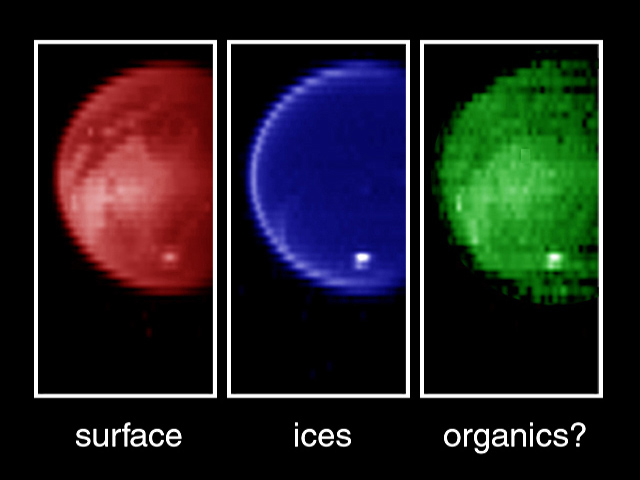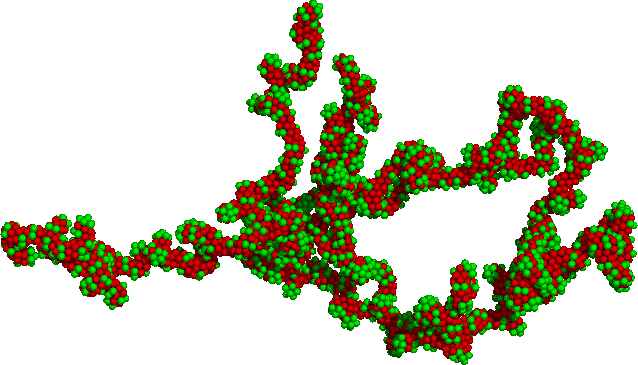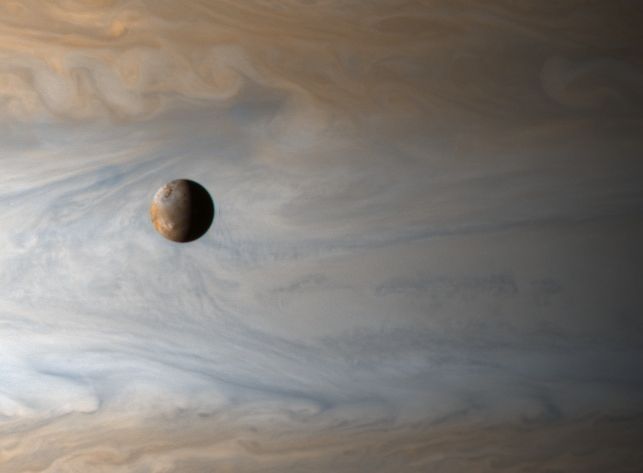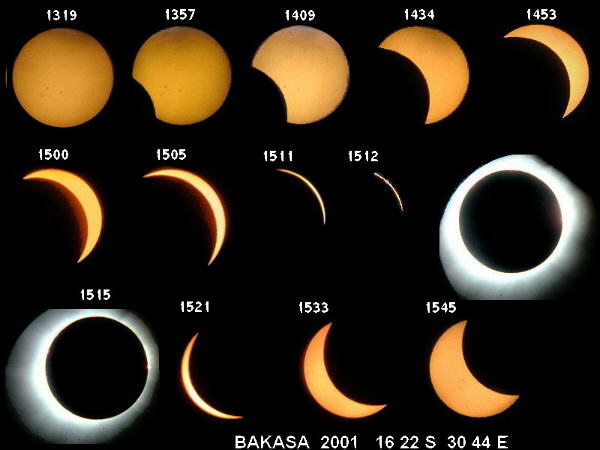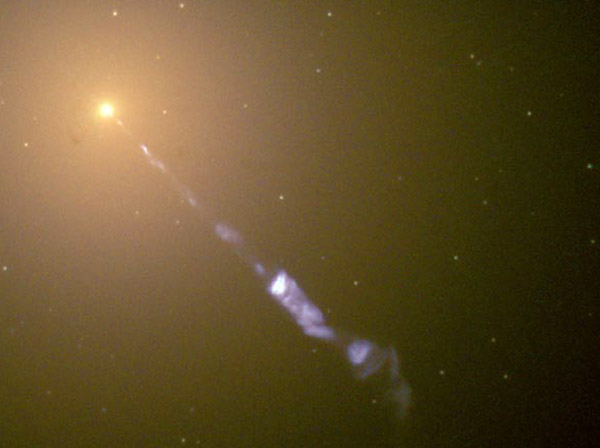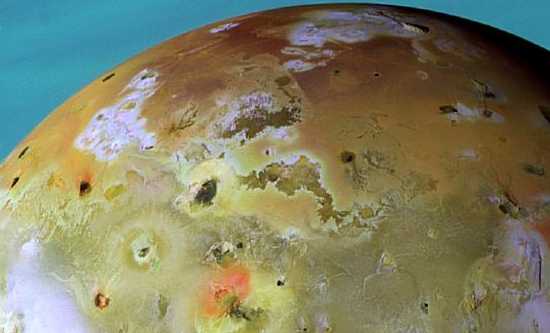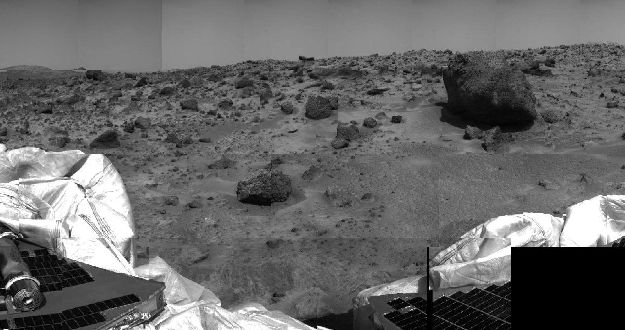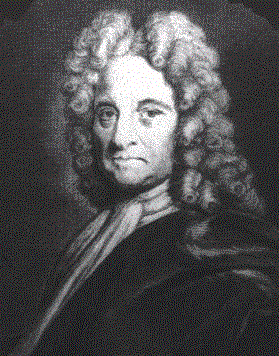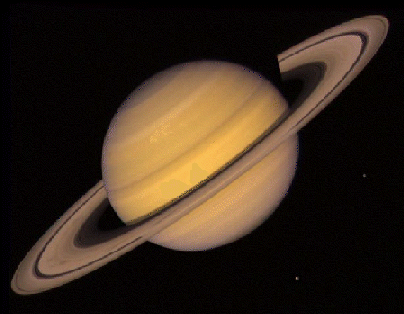| << Previous | Index | Next >> |
2015 Why is the sky near Antares and Rho Ophiuchi so colorful? The colors result from a mixture of objects and processes. Fine dust illuminated from the front by starlight produces blue reflection nebulae. Gaseous clouds whose atoms are excited by ultraviolet starlight produce reddish emission nebulae. Backlit dust clouds block starlight and so appear dark. Antares, a red supergiant and one of the brighter stars in the night sky, lights up the yellow-red clouds on the lower center of the featured image. Rho Ophiuchi lies at the center of the blue nebula on the left. The distant globular cluster M4 is visible to the upper right of center. These star clouds are even more colorful than humans can see, emitting light across the electromagnetic spectrum.
2014 This coming Saturday, if it is clear, well placed New Yorkers can go outside at sunset and watch their city act like a modern version of Stonehenge. Manhattan's streets will flood dramatically with sunlight just as the Sun sets precisely at each street's western end. Usually, the tall buildings that line the gridded streets of New York City's tallest borough will hide the setting Sun. This effect makes Manhattan a type of modern Stonehenge, although only aligned to about 30 degrees east of north. Were Manhattan's road grid perfectly aligned to east and west, today's effect would occur on the Vernal and Autumnal Equinox, March 21 and September 21, the only two days that the Sun rises and sets due east and west. Pictured above in this horizontally stretched image, the Sun sets down 34th Street as viewed from Park Avenue. If Saturday's sunset is hidden by clouds do not despair -- the same thing happens twice each year: in late May and mid July. On none of these occasions, however, should you ever look directly at the Sun.
2013 The universe is filled with galaxies. But to see them astronomers must look out beyond the stars of our own galaxy, the Milky Way. This colorful Hubble Space Telescopic portrait features spiral galaxy NGC 6384, about 80 million light-years away in the direction of the constellation Ophiuchus. At that distance, NGC 6384 spans an estimated 150,000 light-years, while the Hubble close-up of the galaxy's central region is about 70,000 light-years wide. The sharp image shows details in the distant galaxy's blue star clusters and dust lanes along magnificent spiral arms, and a bright core dominated by yellowish starlight. Still, the individual stars seen in the picture are all in the relatively close foreground, well within our own galaxy. The brighter Milky Way stars show noticeable crosses, or diffraction spikes, caused by the telescope itself.
2012 A mere 30 million light-years away, large spiral galaxy NGC 3628 (center left) shares its neighborhood in the local Universe with two other large spirals, in a magnificent grouping otherwise known as the Leo Triplet. In fact, fellow trio member M66 is near the center right of this deep cosmic group portrait, with M65 just above it and to the left. But, perhaps most intriguing is the spectacular tail stretching up and to the left for about 300,000 light-years from NGC 3628's warped, edge-on disk. Know as a tidal tail, the structure has been drawn out of the galaxy by gravitational tides during brief but violent past interactions with its large neighbors. Not often imaged so distinctly, the tidal tail is composed of young bluish star clusters and star-forming regions.
2011 Tycho crater's central peak complex casts a long, dark shadow near local sunrise in this spectacular lunarscape. The dramatic oblique view was recorded on June 10 by the Lunar Reconnaissance Orbiter. Shown in amazing detail, boulder strewn slopes and jagged shadows appear in the highest resolution version at 1.5 meters per pixel. The rugged complex is about 15 kilometers wide, formed in uplift by the giant impact that created the well-known ray crater 100 million years ago. The summit of its central peak reaches 2 kilometers above the Tycho crater floor.
2010
2009 What is that strange material on Mercury? When flying by Mercury last October, the robotic MESSENGER spacecraft imaged much of the solar system's innermost planet in unprecedented detail. As common in science, new data bring new mysteries. Pictured above on the lower right, a large crater -- about 100 kilometers across -- has unusual dark material of unknown composition near its center. The material's darkness does not appear to be caused by shadows, as the Sun was near zenith when the image was taken. One origin hypothesis is that the dark material was uncovered from beneath Mercury's surface during the impact that created the surrounding crater. If so, the composition of the dark mound might be similar to the composition of some mysterious dark rings also recently discovered on Mercury. Alternatively, the dark material could be related to an unusual composition of the impacting rock. MESSENGER will buzz past Mercury again later this year before entering orbit in 2011.
2008 Get out your red/blue glasses and check out this stereo scene from Taurus-Littrow valley on the Moon! The color anaglyph features a detailed 3D view of Apollo 17's Lunar Rover in the foreground -- behind it lies the Lunar Module and distant lunar hills. Because the world was going to be able to watch the Lunar Module's ascent stage liftoff via the rover's TV camera, this parking place was also known as the VIP Site. In December of 1972, Apollo 17 astronauts Eugene Cernan and Harrison Schmitt spent about 75 hours on the Moon, while colleague Ronald Evans orbited overhead. The crew returned with 110 kilograms of rock and soil samples, more than from any of the other lunar landing sites. Cernan and Schmitt are still the last to walk (or drive) on the Moon.
2007 Spiral galaxy NGC 2903 is only some 20 million light-years distant in the constellation Leo. One of the brighter galaxies visible from the northern hemisphere, it is surprisingly missing from Charles Messier's famous catalog of celestial sights. This impressively sharp color image shows off the galaxy's beautiful blue spiral arms. Included in the ground-based telescopic view are intriguing details of NGC 2903's central regions -- a remarkable mix of old and young star clusters with immense dust and gas clouds. In fact, NGC 2903 exhibits an exceptional rate of star formation activity near its center, also bright in radio, infrared, ultraviolet, and x-ray bands. Just a little smaller than our own Milky Way, NGC 2903 is about 80,000 light-years across.
2006 NGC 6888, also known as the Crescent Nebula, is a cosmic bubble about 25 light-years across, blown by winds from its central, bright, massive star. Near the center of this intriguing widefield view of interstellar gas clouds and rich star fields of the constellation Cygnus, NGC 6888 is about 5,000 light-years away. The three color composite image was created by stacking exposures through narrow band filters that transmit the light from atoms in the clouds. Hydrogen is shown as green, sulfur as red, and oxygen as blue. NGC 6888's central star is classified as a Wolf-Rayet star (WR 136) and is shedding its outer envelope in a strong stellar wind, ejecting the equivalent of our Sun's mass every 10,000 years. Burning fuel at a prodigious rate and near the end of its stellar life, this star should ultimately go out with a bang in a spectacular supernova explosion.
2005 This diverse landscape is the surface of comet Temple 1's nucleus as seen by the Deep Impact probe's Impactor Targeting Sensor. Within minutes of recording the rugged view, the landscape had changed dramatically though, as the impactor smashed into the surface near the two large, half kilometer-sized craters at picture center. Indications are that the probe penetrated well below the surface before vaporizing, sending a relatively narrow plume of debris blasting back into space. Researchers are still speculating on the final size of the crater produced by the July 4th comet crash, but material continues to spew from the impact site and has caused the faint comet to brighten significantly. Determining the crater dimensions and analyzing the debris ejected from the comet's interior will provide premier insights into the formation of comet Tempel 1, a primordial chunk of our own solar system.
2004 Could the building blocks of life exist under the smog of Titan? What is creating all of the methane? To help answer these questions, the largest and most mysterious moon of Saturn got a quick first look from the Cassini robot spacecraft soon after entering orbit around the giant planet last week. Although thick atmospheric smog prevented detailed surface images in visible light, infrared light was able to provide interesting clues to the nature of Titan's surface. The above images show Titan in three different colors of infrared light, with the most energetic on the left. The leftmost image is the most detailed but shows surface features that are not yet well understood. The smoothness of the middle image is consistent with a large frozen ocean of water ice containing simple hydrocarbons. The darker regions on the rightmost image might indicate areas relatively rich in hydrocarbons. The white spot visible near the South Pole is hypothesized to be a persistent cloud of large particles containing methane. A better understanding of the mysterious surface of Titan will hopefully be forthcoming as scientists study these images and those from a planned 45 flybys over the next four years. In January, Cassini is scheduled to drop the Huygens probe onto Titan's surface.
2003 Our universe is a very dusty place. Dust usually shows its presence by blocking out light emitted from stars or nebulae behind it, sometimes creating the illusion of a horse's head or a sombrero hat. But nobody really knows what a typical interstellar dust grain looks like. By studying how dust absorbs, emits, and reflects light, astronomers do know that interstellar dust is much different than the cell and lint based dust found around a typical house. Interstellar dust grains are composed mostly of carbon, silicon, and oxygen and are usually less than about 1/1000 of a millimeter across. Recent work indicates that most dust grains are not spherical. The above picture shows the result of a fractal adhesion model for dust grains involving random conglomerates of spherical compounds of different properties, here artificially highlighted by different colors.
2002 How big is the Jovian moon Io? The most volcanic body in the Solar System, Io (usually pronounced "EYE-oh") is 3,600 kilometers in diameter, about the size of planet Earth's single large natural satellite. Gliding past Jupiter at the turn of the millennium, the Cassini spacecraft captured this awe inspiring view of active Io with the largest gas giant as a backdrop, offering a stunning demonstration of the ruling planet's relative size. Although in the picture Io appears to be located just in front of the swirling Jovian clouds, Io hurtles around its orbit once every 42 hours at a distance of 420,000 kilometers or so from the center of Jupiter. That puts it nearly 350,000 kilometers above Jupiter's cloud tops, roughly equivalent to the distance between Earth and Moon. The Cassini spacecraft itself was about 10 million kilometers from Jupiter when recording the image data.
2001 Starting at the upper left, this sequence of images follows the progress of the magnificent 21 June, 2001 solar eclipse in the clear skies over Bakasa, Zimbabwe. These pictures were recorded using a small reflecting telescope and digital camera with the approximate local time given above each frame. A simple pair of "eclipse spectacles" were mounted as a filter in front of the telescope mirror and removed during totality. In the early and late phases of this eclipse of the active Sun, sunspot groups can be seen lingering on the solar surface. During eclipse totality, pinkish prominences are visible at the solar limb along with details of the normally hidden solar corona. Seen from this location, the total eclipse phase lasted just under 3 1/2 minutes as the Moon's shadow rushed across northern Zimbabwe at nearly 5,000 kilometers per hour.
2000 What's causing a huge jet to emanate from the center of galaxy M87? Although the unusual jet was first noticed early in the twentieth century, the exact cause is still debated. The above recently released picture taken by the Hubble Space Telescope shows clear details, however. The most popular hypothesis holds that the jet is created by energetic gas swirling around a massive black hole at the galaxy's center. The result is a 5000 light-year long blowtorch where electrons are ejected outward at near light-speed, emitting eerily blue light during a magnetic spiral. M87 is a giant elliptical galaxy residing only 50 million light-years away in the Virgo Cluster of Galaxies. The faint dots of light surrounding M87's center are large ancient globular clusters of stars.
1999 Have you ever seen a sun pillar? When the air is cold and the Sun is rising or setting, falling ice crystals can reflect sunlight and create an unusual column of light. Ice sometimes forms flat, stop-sign shaped crystals as it falls from high-level clouds. Air resistance causes these crystals to lie nearly flat much of the time as they flutter to the ground. Sunlight reflects off crystals that are properly aligned, creating the sun-pillar effect. In the above picture, the sun-pillar can be traced up to the cloud that is raining the reflecting ice-crystals.
1998 What's cooking on Io? This active moon of Jupiter is marked with volcanoes spewing lava that is now known to be hotter than any lava on Earth. Above is the highest resolution color-enhanced image yet composed of the most active surface in our Solar System. Features as small as three kilometers are visible. Sulfur compounds cause many of Io's unusual colors, while darker regions are probably composed of silicate rock.
1997 A Day or "Sol" on Mars is only 40 minutes longer than an Earth day - and Pathfinder's first day on Mars, Sol 1 according to its local calendar, was an eventful one. Still, late in the martian afternoon of Sol 1, the camera on board the Mars Pathfinder spacecraft recorded this panorama of the ancient floodplain Ares Vallis. Two of the three landing petals lie in the foreground at the edges of this scene surrounded by deflated and partially gathered airbags. The martian soil near the spacecraft has been disturbed by the airbag retraction. The petal holding the undeployed robot rover Sojourner is at the left. One of Sojourner's planned routes to the surface will be down the ramp seen rolled up at the petal's edge. Mission teams have overcome some rover communications problems and are proceding carefully with plans to roll the Sojourner out onto the martian surface. NASA has announced that the Pathfinder station on Mars will be renamed in honor of astronomer Carl Sagan.
1996 Sir Edmond Halley was quite a discoverer. Born in 1656, he computed in 1705 that a bright comet was periodic and would make another appearance in 1758. The comet appeared as predicted and is now known as Comet Halley. Unfortunately, Halley died in 1742 and never saw his prediction come true. In 1716 Halley proposed two types of diving bells that would enable people to explore the deep sea. Halley pioneered our understanding of trade winds, tides, cartography, naval navigation, mortality tables, and stellar proper motions. Halley (incorrectly) proposed that the Earth was made of concentric spheres the size of the inner planets each of which might contain life. Perhaps Halley's greatest discovery, however, was that his contemporary Isaac Newton had discovered a powerful mathematical formulation of gravity.
1995 This image of Saturn was made by NASA's robot spacecraft Voyager 2 as it began to explore the Saturn system in 1981. Saturn's famous rings are visible along with two of its moons, Rhea and Dione which appear as faint dots in the right and lower right part of the picture. Astronomers believe that Saturn's moons play a fundamental role in sculpting its elaborate ring system.
| << Previous | Index | Next >> |
